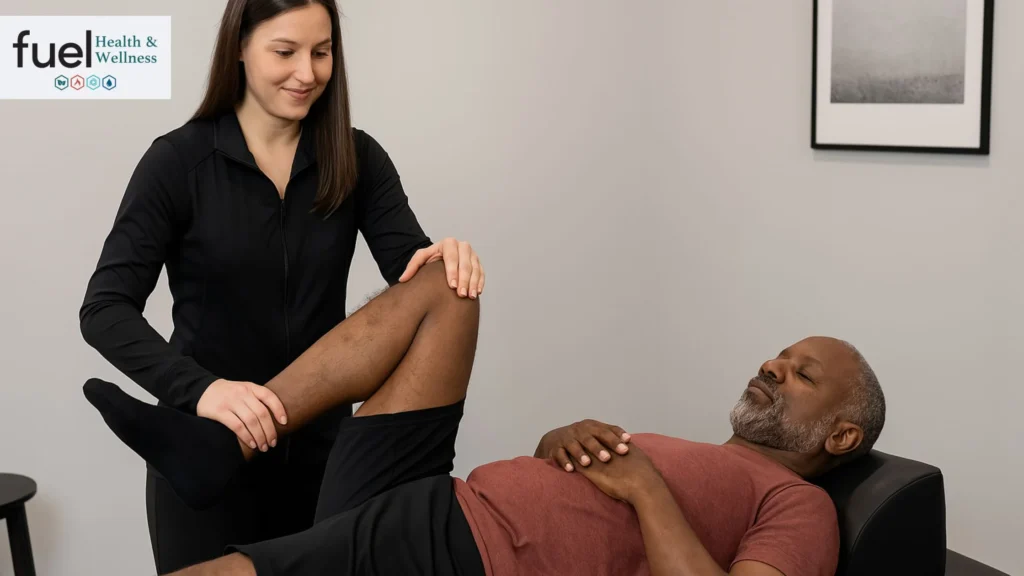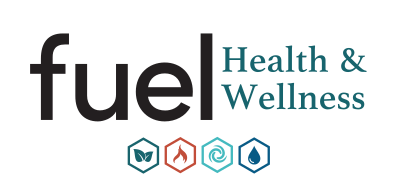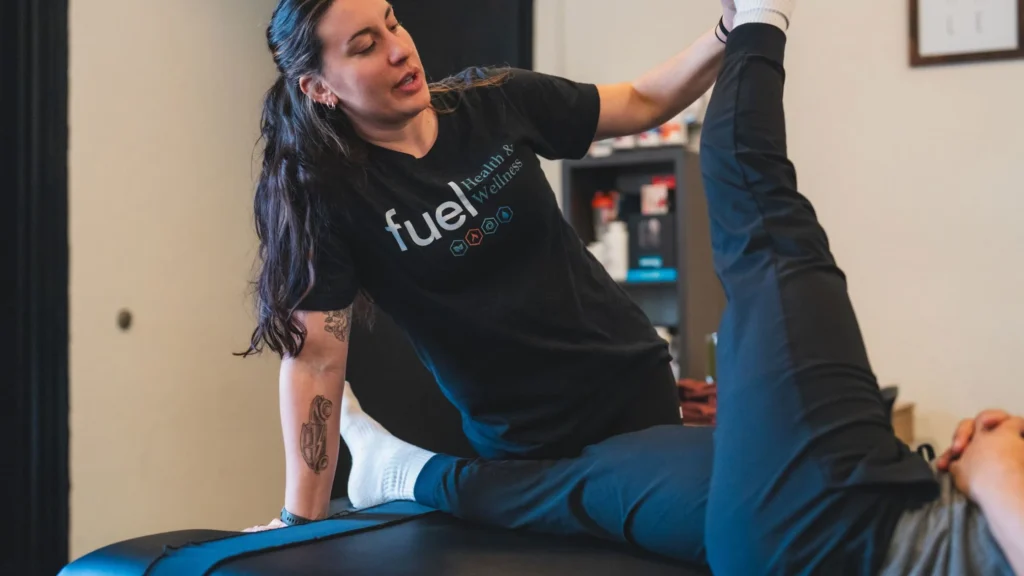Assisted stretch therapy has quietly shifted from a niche recovery tool to a staple of modern wellness. For residents of Grand Rapids, the practice offers more than temporary relief—it builds sustainable mobility, resilience, and an almost effortless sense of “lightness” that traditional stretching rarely provides. This guide pinpoints exactly who gains the greatest return on an assisted stretch investment, why those gains matter, and how a tailored plan turns flexibility into a daily advantage.
What Exactly Is Assisted Stretch Therapy?

Assisted stretch therapy pairs a trained practitioner with the client on a treatment table. Unlike passive static stretches, the specialist guides limbs through precise ranges of motion, targeting the joint capsule, fascia, and surrounding neuromuscular tissue.
- Fuel’s program leverages the Fascial Stretch Technique, a pain-free, strap-supported approach shown to boost range of motion (ROM), reduce soreness, and improve breathing mechanics.
- GRIP Center confirms that techniques engaging the parasympathetic nervous system quickly down-shift stress, often prompting clients to “drift” into relaxed states mid-session.
- Evidence-backed routines, such as those at Exercise Coach, tie gains in flexibility to better posture, balance, and daily function after only a few weeks.
Why the Method Matters
Because the specialist controls angles and tension, tissues reach a depth that solo stretching rarely achieves. In turn, collagen fibers realign, fascia glides more freely, and joints rediscover their full mechanical advantage. That triad underlies every benefit in the remaining sections.
Core Recovery Therapy Benefits
Stretch therapy is a multi-tool: it restores tissue quality, sharpens proprioception, and accelerates the body’s built-in healing cycles. Below is a snapshot of outcomes clients typically notice within the first four to six sessions.
| Recovery Benefit | Mechanism | Timetable to Noticeable Change |
| Increased ROM | Fascial elongation & synovial fluid circulation | 1–2 sessions |
| Reduced DOMS (soreness) | Enhanced lymphatic drainage & micro-tear repair | 2–3 sessions |
| Less joint stiffness | Capsule decompression & neuromuscular re-education | 2–4 sessions |
| Stress reduction | Activation of parasympathetic pathways | Immediate during session |
| Improved athletic force output | Optimal length–tension relationship | 4–6 sessions |
The compounding nature of these benefits means each new appointment builds on the last, creating a feedback loop of improved performance and comfort.
Who Benefits the Most?
Hobbies & High-Performance: Stretch Therapy for Athletes

Athletes—from high school sprinters to Ironman hopefuls—place extraordinary loads on tissue. Over time, microscopic adhesions limit stride length, swing speed, or bar path even when muscles “feel” ready.
- Assisted stretch therapy for athletes in Grand Rapids often focuses on hip capsule distraction, shoulder external rotation, and thoracic spine mobility—three zones linked to explosive power and injury prevention.
- Post-session gait analyses routinely reveal longer strides and smoother arm drive, translating to immediate performance edges.
A well-timed stretch block (e.g., 30 minutes every 7–10 days during peak season) can shave milliseconds off sprint times or enable heavier cleans without adding training stress.
Active & Sedentary Seniors: Stretching for Seniors in Grand Rapids
Aging is not synonymous with stiffness—loss of tissue glide is. Seniors contend with collagen cross-linking, slower nutrient delivery, and habitual postures that cement joint restrictions.
- Guided hip and thoracic rotations restore upright posture, which in turn improves balance and reduces fall risk.
- Gentle neurodynamic stretches reroute blood flow to peripheral nerves, nurturing tingling or neuropathic limbs often dismissed as “just age.”
Because the therapist modulates pressure, sessions remain pain-free and adaptable to osteoporosis or joint replacements. Many local seniors pair stretching with an evidence-based physical therapy program—seamlessly accessible through Fuel’s physical therapy services—to amplify gains.
Desk Workers & Remote Professionals
Eight hours in a forward-flexed position breeds adaptive shortening of the hip flexors, pectorals, and cervical extensors. Assisted stretching counteracts “tech neck,” freeing the thoracic spine and re-training scapular stabilizers.
Mid-career professionals often report that a single 30-minute table session matches the relief of a weekend yoga retreat—without homework poses they rarely maintain. Integrating stretching into lunch breaks boosts afternoon focus by pouring oxygen-rich blood back into the brain.
Post-Rehab or Chronic Pain Clients
Whether recovering from ACL reconstruction or battling chronic low-back pain, the biggest challenge is breaking the cycle of guarded movement. Therapist-controlled stretches introduce safe ranges of motion, desensitize over-protective nerves, and lay groundwork for progressive loading.
Clients coming directly from orthopedic clearance find it convenient to dovetail their table sessions with Fuel’s assisted stretching studio, eliminating commute friction between providers.
Busy Parents & Weekend Warriors
Compressed schedules breed inconsistent warm-ups and cool-downs. The result? Tight calves, overworked lumbar spines, and that stubborn 3 p.m. energy dip. A standing 30-minute weekend slot often becomes a sanity-saving ritual—like rebooting a sluggish smartphone.
Because practitioners guide every movement, parents can mentally “unplug,” letting the session double as “forced mindfulness.”
How an Assisted Session Flows
| Phase | Time | Focus | Sensation |
| Intake & Goals | 5 min | Brief health screen | Conversational |
| Warm-Up Pulses | 3 min | Low-amplitude oscillations | Gentle rocking |
| Progressive Stretch | 20 min | Joint-specific angles & PNF holds | Deep, relaxing pull |
| Integrated Chain Moves | 5 min | Multi-plane mobilizations | Full-body elongation |
| Cool-Down | 2 min | Diaphragmatic breathing & reset | Calm, grounded |
This structure is standard across most Grand Rapids clinics, including Fuel, GRIP Center, and Exercise Coach, ensuring continuity no matter where clients book.
During the integrated chain portion, therapists may loop supportive straps around the foot or hand—a hallmark of the fascial technique that keeps leverage safe while achieving otherwise impossible ranges.
Internal (and Local) Ecosystem of Care
Grand Rapids’ wellness network excels when services interlock:
- An assisted stretch therapy in Grand Rapids ecosystem is forming, highlighted by hubs like Fuel’s dedicated table studio, GRIP Center’s sports-centric practice, and evidence-driven chains.
- Clients discovering improved ROM often transition into strength or Pilates classes. Likewise, those originating in training programs slip comfortably into stretch blocks for restoration.
Residents ready to blend both worlds schedule via Fuel Health Wellness, where care coordinators match individual needs—athletic, geriatric, or post-surgical—to therapists with niche expertise.
Answering the Big Questions
Q1. How often should athletes schedule sessions?
Plan for weekly 30-minute appointments in-season, tapering to biweekly maintenance in the off-season to cement gains.
Q2. Is assisted stretching safe for joint replacements?
Yes. Trained therapists respect post-surgical ROM limits, mobilizing above and below the implant to restore full-chain movement without stressing the hardware.
Q3. Will elderly clients feel sore afterward?
Most report mild, pleasant looseness—comparable to finishing a brisk walk—and negligible soreness thanks to controlled tension and full support.
Q4. Can desk workers replace exercise with stretching?
Stretching boosts posture and circulation but does not raise heart rate sufficiently for cardiovascular health. Pair it with at least 150 minutes of moderate activity per week.
Q5. How quickly are benefits noticeable?
Many feel lighter after one visit; measurable ROM improvements surface within 1–2 sessions for most body regions.
The Grand Rapids Difference
What distinguishes the city’s stretch scene is collaboration. Clinics happily cross-refer: an athlete might pursue fascial stretch at GRIP, fine-tune mechanics with Fuel’s sports PT, and maintain softness at Exercise Coach’s posture sessions.
Residents who crave a single hub can schedule an introductory session through Fuel’s contact portal and explore add-ons like dry needling or cupping under one roof.
Conclusion
Assisted stretch therapy is not a luxury; it is targeted maintenance for joints, fascia, and the nervous system—especially valuable when athletic demand, age-related stiffness, or prolonged sitting conspire against easy movement.
Grand Rapids offers a uniquely robust network of practitioners, ready to guide everyone from marathon hopefuls to retirees into freer, more efficient motion. By aligning session frequency with life stage and activity level, clients transform stretching from an afterthought into a strategic advantage.Service proudly offered by Fuel Health Wellness, where mobility meets performance.


